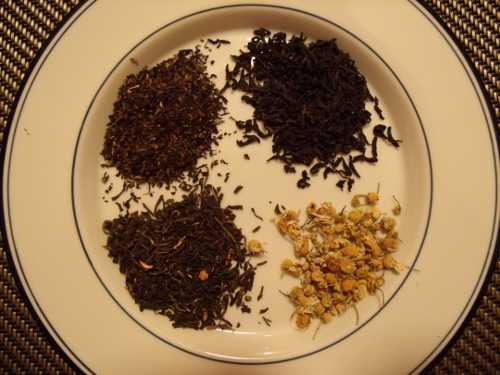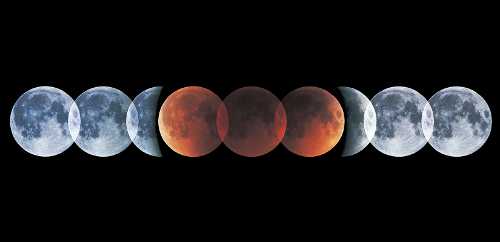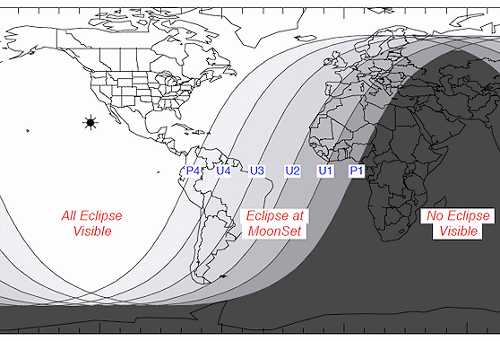
Shown clockwise from bottom left are jasmine tea made with green tea leaves (the white flecks are jasmine blossoms): Darjeeling tea, also made with green leaves; Lapsong Souchong, a black tea made by drying leaves over a pinewood fire, giving it a characteristic smoky taste; and dried chamomile blossoms for an herbal infusion. Photo by Esther Oertel.
The Christmas season is one of the busiest times of year for many of us, with parties, shopping, cooking, family visits and the like. In the midst of the busyness, I’d like to extend a special invitation to you to put aside your to-do list for just a few minutes and enjoy a cup of tea with me.
Other than water, tea is the most ubiquitous drink in the world, meaning it’s more common than any other type of food or drink. Its world consumption easily equals all the other manufactured drinks on the planet put together – that is, coffee, chocolate, sodas and alcoholic drinks.
What are the origins of this mysterious liquid and how did it become so popular? Some of that can’t be answered, but let’s explore what’s known.
A few thousand years ago, no one on earth drank tea; however, a few small tribal groups in the jungles of Southeast Asia chewed on the leaves of the plant.
Two thousand years ago, it was drunk by a handful of religious communities in China. Within a thousand years, its popularity reached outside monastery walls and it was drunk by millions of ordinary Chinese.
Over the next five centuries, it spread outside of China, so by 500 years ago, over half the world’s population was drinking tea as the main alternative to water.
By the 1930s, there were enough tea leaves harvested to serve 200 cups of tea a year to every person in existence.
Tea is an evergreen plant grown in tropical and subtropical climates. While it’s known that it originated in the jungles of the eastern Himalayas, it’s unknown by whom it was first domesticated.
Early tribesmen began chewing the leaves for its stimulating and relaxing qualities, and this habit continues today in many places. Some historians speculate that the first humans to try this may have been mimicking monkeys.
It wasn’t until much later that tea leaves were infused in water.
True tea is only from the plant species Camellia sinensis, of which there are two principal varieties. The China plant is used for most Chinese, Formosan and Japanese teas, and the Assam plant is used in most Indian and other teas.
Interestingly, one of India’s most famous teas, Darjeeling (also known as “the champagne of teas” because of its light taste) is made from Chinese leaves.
A tea plant can grow into a tree of 52 feet if left undisturbed, but when cultivated is pruned to waist height for ease of harvesting.
The type of tea – whether it’s white, yellow, green, oolong or black – depends on the processing it goes through after it’s picked.
Tea leaves begin to wilt and oxidize shortly after picking if not dried quickly. During this process, the leaves turn progressively darker as the chlorophyll breaks down and tannins are released. This is known as fermentation, though it’s not a true fermentation caused by microorganisms; rather, it’s enzyme oxidation.
White tea is comprised of wilted leaves that are not oxidized. Yellow tea is the same, but is allowed to turn yellow.
Green tea is not oxidized either, but is made from unwilted leaves. Oolong tea is wilted, bruised and partially oxidized, while black tea is wilted, sometimes bruised and fully oxidized.
Herbal “teas” are more correctly called herbal infusions as they don’t contain true tea leaves; rather, they’re made with flowers, fruits or herbs.
Tea has been considered a potent medicine in Asia since the seventh century, when the practice of using tea medicinally began in China. Today we know that tea has a number of health benefits, almost too numerous to mention.
Green tea has been shown to protect against a range of cancers, including lung, prostrate and breast. Studies on white tea indicate that it may be even more effective in this arena.
Studies show that both green and black tea may help prevent diabetes. Tea boosts the immune system. According to research, it reduces the risk of stroke, promotes cardiovascular health, and has antidepressant properties.
Tea has a positive effect on mental alertness. It has been shown that green tea lowers the rate of change of cognitive impairment in the elderly.
Throughout history tea has performed another purpose: giving humans something safe to drink.
Waterborne diseases spread when city civilizations emerged. Because of boiling water, tea became a safe drink as an alternative to water.
Chinese Emperor Shen Nung (who, by the way, may be mythical) is said to have said, “Tea is better than wine for it leadeth not to intoxication, neither does it cause a man to say foolish things and repent thereof in his sober moments. It is better than water for it does not carry disease; neither does it act like poison as water does when it contains foul and rotten matter.”
Tea was esteemed so highly in ancient China that bricks of it served as early Chinese currency. Believe it or not, tea bricks are still used as currency in remote parts of central Asia.
Different places around the world have their own version of tea culture. Both Japan and China have elaborate tea ceremonies, and the beverage is a focal point in Arab social gatherings.
In North Africa (particularly Morocco and Libya), tea is poured dramatically from a height, both to create a foam atop the glass and to cool it.
In Malaysia, tea pouring from a height has developed into an art form, literally, in which a dance is performed by people pouring tea from one container to another.
In England, tea is both a drink and a meal. The British love their tea, with over 165 million cups of it being served there each year. That’s nearly three cups per day per British citizen.
Tea was first imported into Britain in the 1660s via the marriage of King Charles II to a Portuguese princess, Catherine of Braganza, who brought her habit of drinking tea to the British royal court.
As is true with much historical trivia, there are conflicting stories as to how English tea (meaning the meal) came to be.
The one I like best is that of a duchess who found it difficult making it through the long stretch between the light lunch and late supper that were traditional in England at that time.
She asked her servants to bring her sweets and tea in her chambers in the mid afternoon and enjoyed it so much that it became a daily event. The tradition spread and is now part of English culture.
Another version is that the English brought the Chinese tradition of dim sum, small portions of food served with tea, back to England. Dim sum originated in the Chinese region of Canton, where rural farmers would go to tea houses after working in the fields.
In Cantonese, going to dim sum is usually known as going to “drink tea.” The drinking of tea is as important to dim sum as the food.
Either way, the tradition of a proper English tea is one I’ve always enjoyed. I love the idea of taking time to savor a relaxing cup of tea. I always feel refreshed afterwards.
One of the participants in a recent tea class I taught said she was going to serve a traditional tea to her mother as a Christmas gift. I love the idea of giving the gift of time to someone (not to mention pampering and delicious sweets). I think that sounded like the beginning of a wonderful tradition!
A traditional high tea (one that is more of a meal than a snack) typically consists of a scone course (think lemon curd and Devonshire cream with scones), an appetizer course (for example, cucumber tea sandwiches with the crusts cut off), and a dessert course (such as shortbread cookies or a trifle).
In case you’d like to share tea with a loved one, today’s recipe is for cream scones infused with lavender. These simple yet rich scones can also be made with orange zest and dried cranberries, blueberries and finely chopped walnuts, or any other delectable combination you can conceive.
Culinary lavender may be purchased at a spice store or online at such places as the San Francisco Herb Co.
Enjoy, and have a very merry Christmas!
Lavender cream scones
2 cups all-purpose flour
2 teaspoons sugar
1 teaspoon salt
1 tablespoon baking powder
2 teaspoons dried lavender buds
At least 1 cup heavy cream
Preheat oven to 425 degrees F.
Sift the dry ingredients together into a large bowl.
Add lavender and blend to distribute evenly.
Gradually add just enough cream to form a soft dough.
Knead lightly on a floured board, handling the dough gently to retain the air needed for the scones to rise.
Roll out to a ½ to ¾ inch thickness and cut into rounds with a cookie cutter or sharp knife.
Arrange on an ungreased baking sheet, leaving a ½ inch space between them.
Bake for 10 to 12 minutes, or until golden brown. Makes eight large or 16 small scones.
Esther Oertel, the “Veggie Girl,” is a culinary coach and educator and is passionate about local produce. Oertel teaches culinary classes at Chic Le Chef in Hidden Valley Lake, Calif., and The Kitchen Gallery in Lakeport, Calif., and gives private cooking lessons. She welcomes your questions and comments; e-mail her at This email address is being protected from spambots. You need JavaScript enabled to view it..
Follow Lake County News on Twitter at http://twitter.com/LakeCoNews , on Facebook at http://www.facebook.com/pages/Lake-County-News/143156775604?ref=mf and on YouTube at http://www.youtube.com/user/LakeCoNews .












